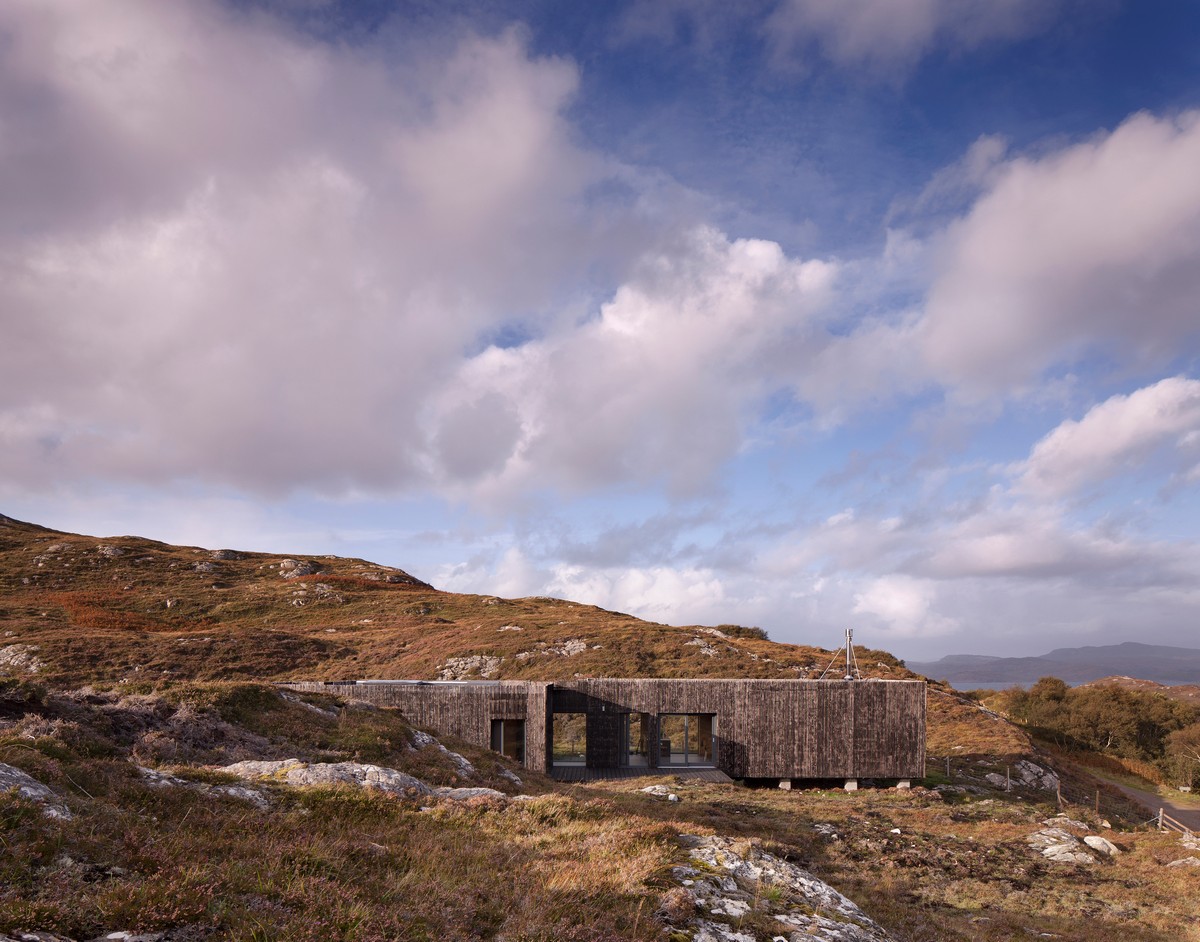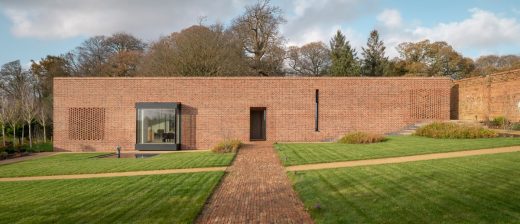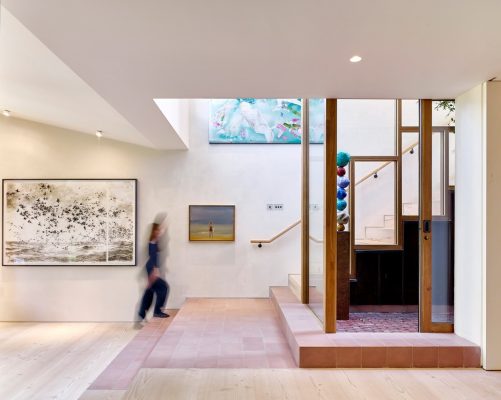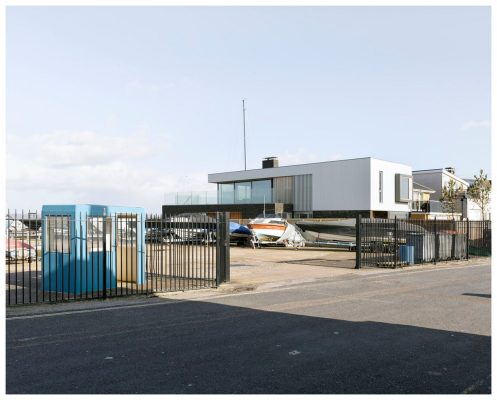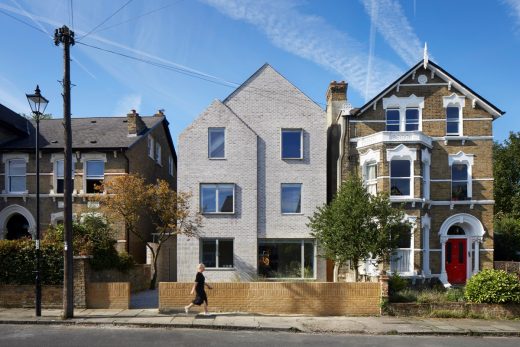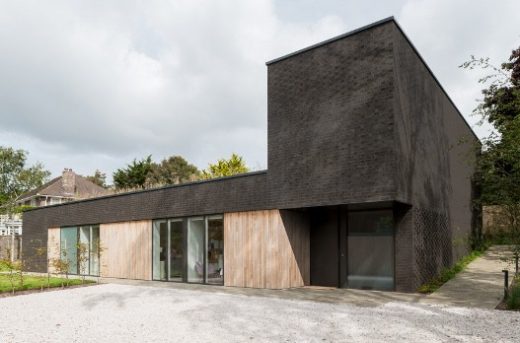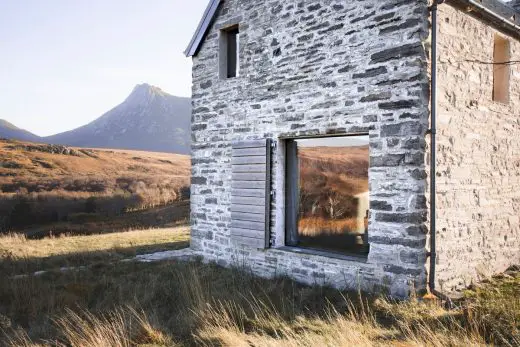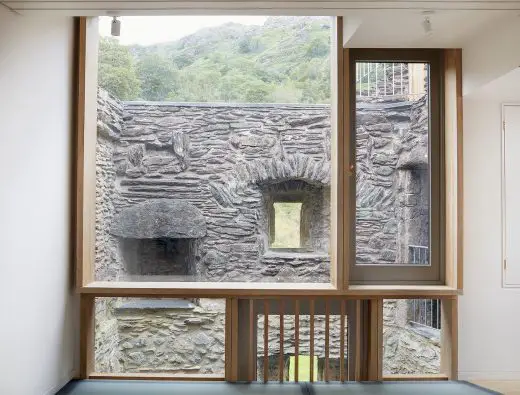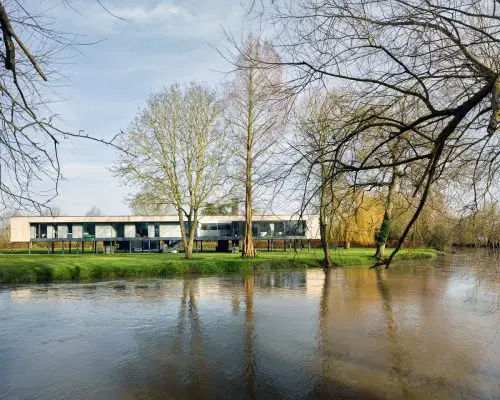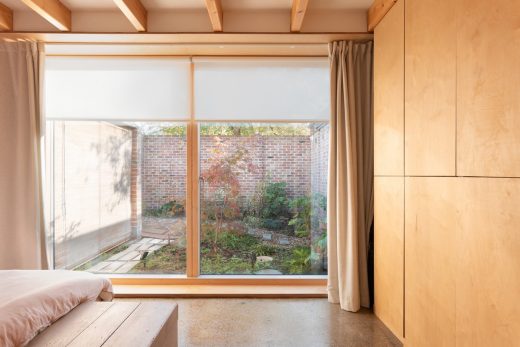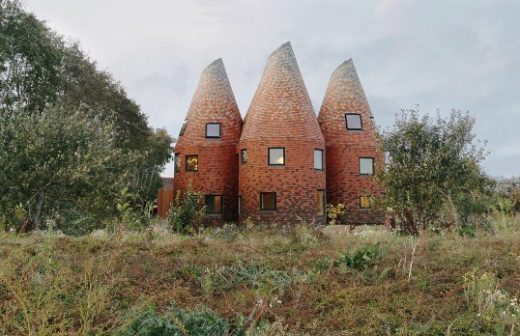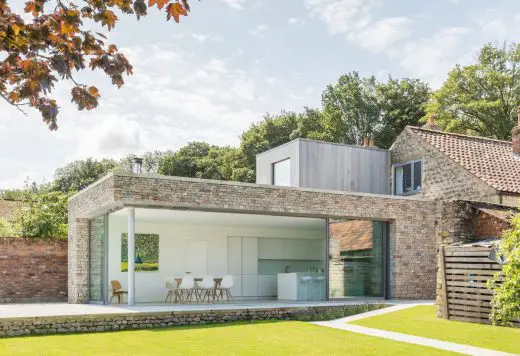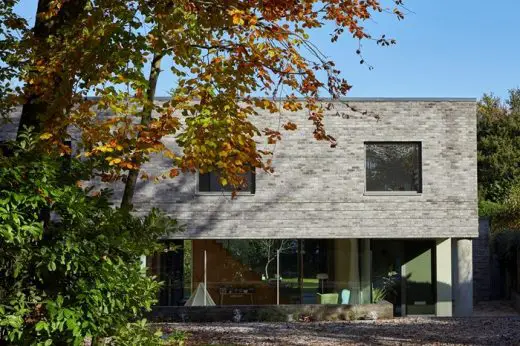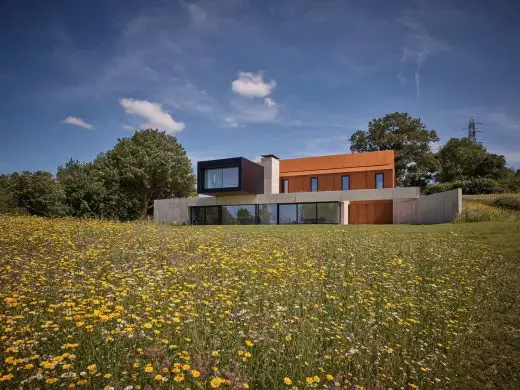RIBA House of the Year 2021 Winners, British Homes Shortlist, Buildings, UK Residential Property Prize
RIBA House of the Year 2021 News
British Home Awards: Architects Prize Shortlist for Best New UK Properties
8 + 5 December + 24 + 18 + 17 November 2021
RIBA House of the Year 2021 winner : House on the Hill by Alison Brooks Architects
RIBA House of the Year 2021 Winner
RIBA House of the Year 2021 Shortlist – Buildings + Architects
Extraordinary Gloucestershire farmhouse extension named UK’s best new house
House on the Hill, a strikingly contemporary extension to a Georgian farmhouse in Gloucestershire, designed by Alison Brooks Architects, has been named RIBA House of the Year 2021. The prestigious annual award is given by the Royal Institute of British Architects (RIBA) to the UK’s best new architect-designed house. The winner was revealed in the final episode of Grand Designs: House of the Year, on Wednesday 8 December at 9pm on Channel 4.
House on the Hill by Alison Brooks Architects:
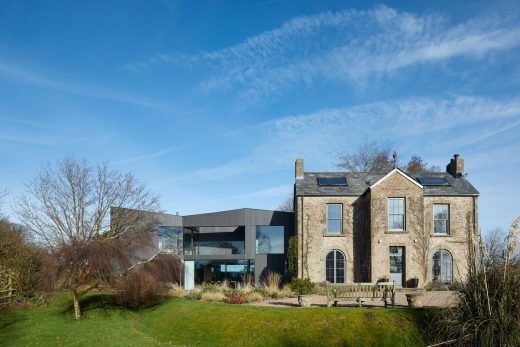
photo : Paul Riddle
House on the Hill by Alison Brooks Architects
To complement its arresting new wing, the 18th century stone farmhouse, which overlooks the Wye Valley in an Area of Outstanding Natural Beauty, has also been meticulously restored. Together the farmhouse and extension create an extraordinary new home for the owners and their art collection. The three-storey farmhouse has been converted into one vast gallery space that seamlessly integrates with the contemporary extension.
Larger than the original house, the new two-storey wing is set back, partially embedded into the hillside, with its dark tones and cladding pattern inspired by the nearby Forest of Dean.
On the ground floor, the kitchen, living and dining areas flow into each other and onto exterior terraces. With the kitchen in the centre, overlooked by a gallery on the floor above, the space is flooded with natural light, and offers up panoramic views of the surrounding landscape, including into a new, bespoke dry-stone-walled garden.
The home’s main staircase doubles-up as a gallery and leads up to two bedrooms, an office and a further terrace.
From the skylights to the walls and the cruciform-steel-columns, the angles throughout the house are intentionally skewed and undulating, echoing the topography of the adjacent meadows, and drawing the eye onwards to new and surprising focal points. Niches, benches and recesses add to the fluidity and playfulness of the space and provide practical areas to display the owner’s art.
Ground and air source heat pumps and solar panels work together to reduce the building’s overall energy consumption, and the new wing has an extensive green roof planted with native wildflowers to reduce rainwater loss. As part of the renovations, the surrounding grounds have also been revitalised with new wildflower meadows and orchards, bordered by hedges that have been repaired and renewed with pollen-rich species of plants.
RIBA President, Simon Allford said:
“This geometric design skilfully fuses together the old with the new – connecting two architectures separated by over 300 years.
Intriguing and distinguished, House on the Hill is the impressive result of a ten-year collaboration between the homeowners and their architect. This is an extraordinary labour of love in architectural form.
Every detail has been meticulously considered and exquisitely finished, resulting in a truly remarkable home that enhances its unique setting.”
Architect, Alison Brooks said:
“It’s a real honour to win RIBA House of the Year amongst an accomplished shortlist of beautiful projects. I see private house commissions as a rare opportunity to test new ideas in a concentrated form – they are the built equivalent of writing an essay. So, this accolade is a testament to my client’s belief in the value of architecture and their willingness to embrace the new. I’m grateful for their trust in me and my team of talented architects, in Akera Engineers and the brilliant team of builders and gardeners whose skilful contributions produced this remarkable house and gardens, that together reveal a new way of living in the landscape.”
David and Jenny, the owners of House on the Hill said:
“Ours was a very protracted project, so the client and architect relationship had to be one of mutual confidence. It was always a pleasure working with Alison and her project architects and we learned a great deal in the process.
The interplay of the house and its gardens with the wider surrounds provides an ever-changing source of pleasure. The house is in an Area of Outstanding Natural Beauty and the house, and the landscape complement each other. To return to the house after a spell away is to renew our admiration of the scheme.
To win this important accolade is an endorsement of the creativity of Alison Brooks Architects.”
Chair of the RIBA House of the Year 2021 jury, architect Amin Taha, said:
“Some decades in the making, the replacement of a very large 1970s shed housing a pool and ancillary spaces with Alison Brooks Architects lower scaled and fragmented form impressed the jury, in a highly competitive year with contenders excelling in sustainability, craftsmanship, reuse, economy of means and thought-provoking sensitivity. House on the Hill balanced these where others may have, for instance reused but at disproportionate cost, or crafted but to no innovative end.
The jury felt Alison Brooks Architects had applied their long-researched process of subtly breaking down the rigid and spatially predictable grid with gentle inflection. Adding depth of scale and richness of experience to the existing house, and through the new extension, transitioning with ease into the beautifully landscaped gardens.
It is a model of architectural approach applicable to all scales, resulting from the architects’ long practiced ideas and the clients’ successful collaboration.”
House on the Hill was revealed as the winner in the final episode of the Channel 4 series Grand Designs: House of the Year, broadcast on 8 December 2021.
Also announced this evening was the seventh and final home shortlisted for the RIBA House of the Year 2021: Corner House by 31/44 Architects.
Corner House
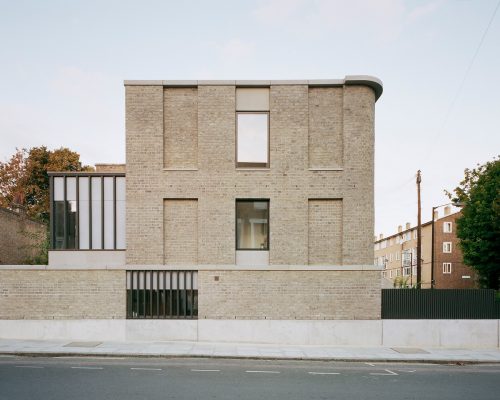
photo : Rory Gardiner
The full shortlist for the RIBA House of the Year 2021 was:
• Corner House by 31/44 Architects
• House for Theo and Oskar by Tigg + Coll Architects
• House in Assynt by Mary Arnold-Forster Architects
• House on the Hill by Alison Brooks Architects
• The Outfarm by TYPE Studio
• The Slot House by Sandy Rendel Architects with Sally Rendel
• The Water Tower by Tonkin Liu
The jury for the House of the Year 2021 was: Amin Taha (Chair), Chairman of GROUPWORK; Cany Ash, Co-founder of Ash Sakula Architects; Kieran McGonigle, Co-founder of McGonigle McGrath and RIBA House of the Year 2019 winner.
Sustainable Scottish Highland home and stone barn conversion in Devon added to RIBA House of the Year shortlist
House in Assynt – a sustainably built timber home with spectacular views on the west coast of Scotland – and The Outfarm – an exquisite conversion of an early 19th century stone barn, once used to house prize cattle in Devon – are the fifth and sixth homes to be shortlisted for RIBA House of the Year 2021.
The annual award is presented to the best new architect-designed house or extension in the UK. The winner will be revealed on Grand Designs: House of the Year, next Wednesday 8 December at 9pm on Channel 4.
House in Assynt
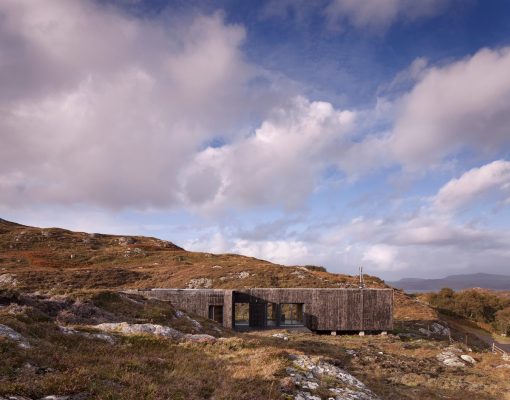
photo © David Barbour Photography
The Outfarm
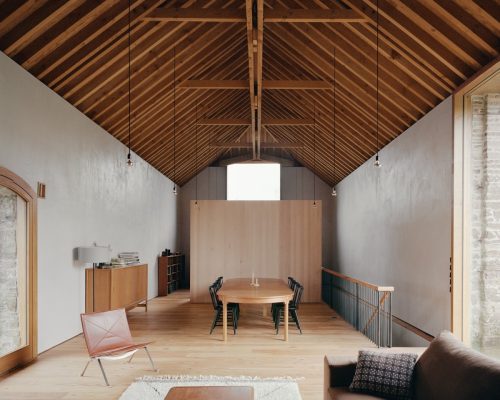
photo : Rory Gardiner
South London ‘skinny house’ and renovated 1930s Surrey bungalow added to RIBA House of the Year shortlist
Wednesday 24th of November 2021 – The Slot House – a two-storey ‘skinny house’ inserted into a disused alley in Peckham – and House for Theo and Oskar – a 1930s bungalow in Surrey, that has been remodelled and extended to create a fully accessible, open plan family home – are the third and fourth homes to be shortlisted for RIBA House of the Year 2021.
The Slot House
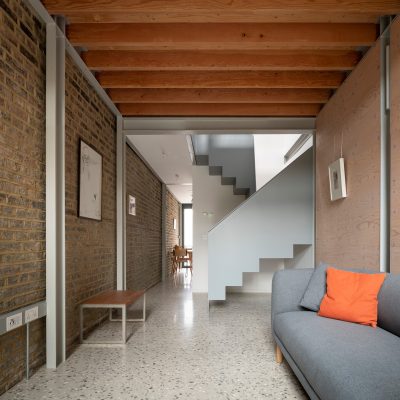
photo : Jim Stephenson
House for Theo and Oskar
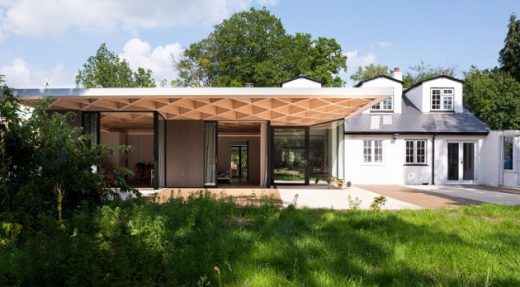
photo : Andy Matthews – ABSTRACT
Previously on e-architect:
Restored water tower and farmhouse extension shortlisted for RIBA House of the Year 2021
The Water Tower – a 1950s steel water tower converted into a home in rural Norfolk – and House on the Hill – an imaginative, contemporary extension to an 18th century farmhouse in Gloucestershire overlooking the Wye Valley – are the first two homes to be shortlisted for RIBA House of the Year 2021.
The annual award is presented to the best new architect-designed house or extension in the UK, with the shortlisted houses revealed on Grand Designs: House of the Year, Wednesdays at 9pm on Channel 4.
House on the Hill design by Alison Brooks Architects:

photograph : Paul Riddle
The Water Tower design by Tonkin Liu:

photograph : Dennis Pedersen
Previously on e-architect:
28 Oct 2021
UK’s best new homes – RIBA announces House of the Year 2021 longlist
Shortlist and winner to be revealed on Channel 4’s Grand Designs: House of the Year
RIBA House of the Year 2021 Longlist
Thursday 28 October 2021 – The Royal Institute of British Architects (RIBA) has announced the longlist for the RIBA House of the Year 2021.
Among the 20 projects in the running to win the UK’s most prestigious award for a new house or extension are:
- A highly-sustainable home built on land that once belonged to the gardens of a large country house in Devon (Devon Passivhaus)
- A skilfully restored stone cottage in the wilds of the Scottish Highlands (Kyle House)
- An elegantly simple home, perched on stilts over the River Thames floodplain in Berkshire (River House)
- The imaginative remodelling and extension of a semi-detached Victorian house in East London (Grain House)
The 20 longlisted homes are:
- Corner House (London) by 31/44 Architects
- Devon Passivhaus (Devon) by McLean Quinlan
- Grain House (London) by Hayhurst & Co Architects
- Harbour House (Hampshire) by John Pardey Architects
- House for Theo and Oskar (Surrey) by Tigg + Coll Architects
- House in Assynt (Sutherland, Scotland) by Mary Arnold-Forster Architects
- House on the Hill (Gloucestershire) by Alison Brooks Architects
- House-within-a-House (London) by alma-nac
- Hove House (Brighton) by Turner Works
- Kyle House (Sutherland, Scotland) by Groves-Raines Architects
- The Modern Oast (Kent) by ACME
- The Old School (Yorkshire) by ArkleBoyce Architects
- The Outfarm (Devon) by TYPE Studio
- Pele Tower House (Cumbria) by Woollacott Gilmartin Architects
- River House (Berkshire) by John Pardey Architects
- Simple House (Cambridge) by Haysom Ward Miller Architects
- The Slot House (London) by Sandy Rendel Architects with Sally Rendel
- The Water Tower (Norfolk) by Tonkin Liu
- Weybridge House (Surrey) by Wilkinson King Architects
- Wolds Barn (Yorkshire) by ID Architecture
The shortlist and winner of the RIBA House of the Year 2021 will be revealed in the sixth series of Channel 4’s Grand Designs: House of the Year, produced by Naked West (a Fremantle label), airing later this year.
The jury for the 2021 House of the Year is: Amin Taha (Chair), Chairman of GROUPWORK; Co-founder of Ash Sakula Architects, Cany Ash; Co-founder of McGonigle McGrath, Kieran McGonigle (RIBA House of the Year 2019 winner).
RIBA House of the Year 2021 Longlisted Homes
Corner House
RIBA region: London
Architect practice: 31/44 Architects
Date of completion: September 2019
Client company name: CASA London
Project city/town: London
Contract value: Confidential
Internal area: 105.00 m²
Cost per m²: Confidential
Contractor company name: Martins Builders & Decorators Ltd
Consultants:
Structural Engineers: David Salter Associates
Building Control: Quadrant
Awards:
• RIBA Regional Award
• Regional Award Short List
• London Southeast
• House
Jury Report
This new end-of-terrace house, which adheres to the existing line of the street, is the result of a deep and careful study of its local context. It picks out and redeploys elements of the Victorian language of the neighbouring houses in a way that is both thoughtful and playful. It is welcoming and deceptively spacious for such a constrained site.
Entry is at lower-ground floor level through a paved brick front garden with a canopy that mirrors the geometry of the adjacent property’s stairs. Directly above this, an arched window on the upper-ground floor mimics the neighbour’s front door.
The entrance leads to the living quarters and, straight ahead, stairs that rise to the bedrooms above. Appropriately for a comparatively small house, the plan is very efficient, with almost no circulation space.
The detailing and materials are robust but subtle. There are many references and reinterpretation of Victorian elements from the neighbouring houses, including blind windows, cornices, and what from the outside looks like a rear conservatory but is, in fact, a bedroom – and feels right as such.
It is the playful subtlety of the design that wins one over. The pale and elegant brick is light and welcoming, even in gloomy weather: no wonder, then, that a retired architect should have purchased the house.
Devon Passivhaus
RIBA region: Southwest & Wessex
Architect practice: McLean Quinlan
Date of completion: December 2018
Client company name:
Project city/town: Exeter
Contract value: Confidential
Internal area: 388.00 m²
Cost per m²: Confidential
Contractor company name: Goulden & Sons
Consultants:
Quantity Surveyor / Cost Consultant
Hosken Parks
Environmental / M&E Engineers
WARM
Structural Engineers
Airey & Coles
Passivhaus Certification
Cocreate
Awards
• Regional Award Short List
• RIBA House of the Year longlist
• House
Jury Report
Presented with difficulty of placing a family home within the confines of a perceptively well maintained and grandly scaled walled kitchen garden Devon Passivhaus plays the visual trick of apparently not being there at all. The new wall could easily be the old, built in the same handmade rubbed red bricks using the same coursing and mortar.
A wheelbarrow path of brick draws us to one of the garden’s axial doorways with the box bay window already suggesting more than a tool shed might lie behind. Once through we are in a secret garden of courtyards, comfortable domestic spaces, and picture framed views. The layout is both pragmatic, intimate, and deliberately far away from the formality and deference of the working stately garden.
Grain House
RIBA region: London
Architect practice: Hayhurst & Co Architects
Date of completion: April 2019
Client company name:
Project city/town: London
Contract value: Confidendial
Internal area: 210.00 m²
Cost per m²: Confidential
Contractor company name: Rebuild London
Consultants:
Structural Engineers: Webb Yates
Awards:
• RIBA Regional Award
• Regional Award Short List
• London North
• House
Jury Report
The architects have exercised care and imagination in remodelling and extending this Victorian semi-detached house in the de Beauvoir Conservation Area in Hackney.
Designed for a young family, it connects the original to new living spaces by creating an innovative visual link from the entrance through the family spaces to the garden beyond and on to a new artist’s studio at the back of the site.
These inventive interventions result in an unfolding spatial sequence of light-filled interiors, demonstrating an ambitious architectural response to the Victorian house typology.
Prior to the works, the house had been traditionally arranged as a series of cellular rooms with only a narrow servants’ stair connecting the living spaces on the lower- and upper-ground floors.
The new design improves this connection with a two-storey courtyard at the heart of the house that features a new garden at its centre. A new staircase wraps around the courtyard, providing a rich spatial experience and offering views through the house and garden as one moves from one level to the next.
At the lower-ground floor level, the pitched ceiling of the extension helps to define the kitchen. This space includes a dining area with a large window seat that that looks out over the garden. The new artist’s studio at the far end of the garden responds in form to the profile of an old summer house that had previously occupied the site.
Detailed with rigour, the palette of materials includes hand-made tiles, natural lime plaster, pre-patinated copper, and charred larch. Where possible, the timbers are native, chosen to add a maturing depth of texture and character as they age.
The old and the new are clearly legible, with the contrast of styles enhancing the whole.
Harbour House
RIBA region: South
Architect practice: john pardey architects
Date of completion: July 2019
Client company name:
Project city/town: Hayling Island
Contract value: Confidential
Internal area: 265.00 m²
Cost per m²: Confidential
Contractor company name: Rice Projects
Consultants:
Structural Engineers: Eckersley O’Callaghan Ltd
Landscape Architects: Nicholas Dexter Studio
Quantity Surveyor / Cost Consultant: APS Associates
Flood Risk: Ambiental
Awards:
• Regional Award Short List
• RIBA House of the Year longlist
• House
Jury Report
The Montague House is intriguing in both form and context. Approaching on a dull grey rainy day, the upper storey of this house appears to meld into the horizon with a dark grey brick base that feels appropriate to this gritty context at the end of the island. Height and building lines of this house are generated by its neighbours and tight site constraints.
Arriving at the southern street frontage, the front side of the house is, unfortunately but not untypically in this part of Hayling Island a parking zone, with garage used for boat storage and toys. Whilst the generous timber entrance doors are set back within the façade creating a welcome overhang, the overall impression is of a car laden driveway where the grey metal roller garage doors dominate the visitor experience. The architecture experience then is left to the large oriel window at first floor, and whilst dramatic it appears elevationally at odds with the long thin bathroom window adjacent creating a tension that feels unresolved. It is a problem inherent in these highly spatially pressurised contexts but one that needs to be addressed.
The entrance corridor quickly arrives into a double-height ‘knuckle point’ in the plan that helps to alleviate what might otherwise have been a point of tension. The width of the tapering plot demands a central corridor to access rooms on either side, a practical move that feels a reluctant but necessary compromise. Bedrooms are compact with back-to-back en-suites and the family den space on the ground floor is the most successful room on this level with the stunning view beyond the garden to the harbour.
The piece de resistance of this home is the first floor living dining room with generous terrace and stunning view. The large floor to ceiling windows on two sides create a feeling on being on the bridge deck of a ship. The beautifully designed and executed joinery elements create a luxury feeling of crafted attention throughout. This is the heart of the home and is a really great space to linger.
The master-bedroom located on the north (street-side) with large oriel window accommodating a window seat, continues the rather awkward feeling that began externally. The northern view is of a toilet block and whilst the client appears to relish this honesty, I was not convinced and the exposure and immediacy of such a large window to the street felt disconcerting.
Particularly note-worthy is the small but exquisite garden with hardy marine plants that soften the angular lines of the house and hardscaping.
This is a ‘taut’ house on a tight site that is thoughtful and maximizes the stunning setting and albeit limited plot. The architect has used skills and experience to bring drama where it is possible and to take advantage of the views and the garden approach from the north. However, the experience of arrival and some of the internally uninspiring spaces undermine the drama that unfolds above. In many ways the site itself both gives the opportunity for drama and disappointment. It will be a super home and very enjoyable to live in.
House for Theo and Oskar

photo : Andy Matthews – ABSTRACT
RIBA region: Southeast
Architect practice: Tigg + Coll Architects
Date of completion: May 2019
Client company name:
Project city/town: Surrey
Contract value: Confidential
Internal area: 240.00 m²
Cost per m²: Confidential
Contractor company name: Ballymore
Consultants:
Structural Engineers: Engenuiti
Awards:
• RIBA Regional Award
• Regional Small Project of the Year
• Regional Award Short List
• House
Jury Report
Theo and Oskar suffer from Duchenne Muscular Dystrophy. The challenge was to remodel a small family cottage into a home that would cater to the children’s developing needs, considering their reducing mobility and interaction with their environment, both now and in the future.
Whilst the interventions appear radical from the rear, the extension wraps around the side of the cottage to form a new front entrance, maintaining the important existing horizontal eaves line and the suggestion of a pitched roof. The existing approach was stepped so the intention was to provide a ‘budget led’ ramp to allow wheelchair access to the new entrance. The groundworker instead voluntarily graded the entire frontage up to the threshold level so resulting in a more holistic, less ‘Part M’, arrival. Wall cladding was detailed based on the materials the sub-contractor arrived with rather than what was designed & specified, the architects constantly having to think on their feet to maintain site progress but not at the expense of the architecture.
The rear façade is dominated by the timber diagrid roof form, cantilevering over the sliding glazed walls which provide the children’s bedrooms with unincumbered access to the covered terrace. The existing cottage is almost so diminutive that the presence of this low-slung “spaceship” next to it seems not only fun and exciting in equal measure but also curiously appropriate. Inside, the visual connection between the rough, exposed timbers of the original ceilings and those of the new diagrid roof (articulated inside as outside) is very successful and not jarring. The internal circulation has been rationalised with seamlessly integrated pocket sliding doors to afford full access throughout. The identity of the original cottage is not only retained but invigorated.
This project is witness to the client’s commitment to their children’s quality of life to procure a relatively simple intervention in a highly imaginative way; the architect’s commitment to delivering something functional but special in the face a constantly evolving procurement process; and the commitment of the contractors and suppliers who put this building together, offering their time, advice and materials within a very tight budget.
This project is a testament to collaboration.
House in Assynt

photo © David Barbour Photography
Architect practice: Mary Arnold-Forster Architects
Date of completion: May 2018
Client company name: Confidential
Project city/town: Perthshire
Contract value: Confidential
Internal area: 100 m²
Cost per m²: Confidential
Consultants:
Structural Engineer: Carbon Dynamic
Awards:
• RIAS Award
• House of the Year longlist
Jury Report
Arriving at House in Assynt is an unforgettable experience. The tortuous nature of the road and the seemingly inaccessible location of the site create a sense of anticipation on the journey, which is met by curiosity on arrival, and is instantly transformed into marvel as the front door opens.
The quality of natural light and the well-balanced proportions of the spaces reveal themselves along the procession from the front door to the primary living space which culminates with a breath-taking view over the mountains.
Setting aside the innovative off-site fabrication, the transportation and construction challenges and the harsh exposure of the site, this building is an exquisite study in volumetric space and light which has produced a house which is exactly tailored to the client’s brief and is a joy to experience.
House in Assynt is an exemplary model of sustainable and considered architecture which makes as minimal an impact on its environment as is possible and yet which leaves a lasting legacy for its occupants to enjoy.
House on the Hill
House on the Hill
RIBA region: Southwest & Wessex
Architect practice: Alison Brooks Architects
Date of completion: December 2018
Client company name: Private client
Project city/town: Lydney
Contract value: £1,950,000.00
Internal area: 623.00 m²
Cost per m²: £3,130.00 / m²
Contractor company name: E G Carter & Co
Consultants:
Structural Engineers: Akera Engineers
Environmental / M&E Engineers: Peter Deer & Associates
Environmental: Bearwood Associates
Garden Designer: Stoney & Janson
Quantity Surveyor: Measur Construction Consultants
Landscape & Pool House Contractor: Barker & Barker
Trunkarb Tree Surgery: Mark Harris
Environmental Co-ordinator: Helena Ronicle
Jury Report:
A small eighteenth century farmhouse on an exceptionally beautiful site, the highest point of Gloucestershire, has been transformed, in a four-phase programme over ten years, into a very special place, both a home and a gallery of Indian and African sculpture.
House on the Hill is a labour of love by client and architect working together with what appears to have been a complete unity of purpose. An art collection might sometimes be a sobering influence on the liveability of a home, but here the overall mood is never didactic or pompous. The house and its contents represent a near perfect amalgam of architecture, landscape, inhabitation and art that is notably poised and elegant as well as being light, fresh and airy. The overall mood is calm and entirely assured.
The first phase converted the original farmhouse. On one side three storeys have been united into one complex new space to make a lofty but intimate display room. The house’s original stair remains, linking a series of small rooms and culminating in a suspended landing high up in the ridge.
The extension, larger than the original house but clearly subordinate to it, contains a luminous interior. The architect’s distinctive skewed geometries make an architecture of shifted planes in plan, section and elevation. This gives rise to an extraordinarily complex and fully resolved play of solids and voids, and a sense of openness, with carefully considered views in all directions. And yet, underlying the elasticity of the architecture is a strong spatial ordering: the sidelong homage to Mies van der Rohe in the form of delightfully light cruciform steel columns (skewed, of course) is well-founded. As importantly, this carefully calibrated geometrical warping creates a relaxed ambience entirely in tune with the spirit of the project and the place.
A beautifully resolved staircase structure houses a grid of small sculptures. The kitchen commands the heart of the plan. The upstairs rooms – bedrooms, study – are comfortable and full of light. Deep brown fibre cement cladding to the new extension recalls the darkness of the nearby Forest of Dean. It is counterpointed by small flashes of highly polished stainless steel.
The landscape treatment all around the house connects it with its garden, and is outstanding. The project hugely enhances an already lovely setting.
House-within-a-House
RIBA region: London
Architect practice: alma-nac
Date of completion: April 2019
Client company name:
Project city/town: London
Contract value: Confidential
Internal area: 233.00 m²
Cost per m²: Confidential
Contractor company name: David Stewart Building Contractor
Consultants:
Structural Engineers: Constant Structural Design
Energy Assessors: Vision Energy
Approved Building Inspector: JHAI Ltd.
Awards:
• RIBA Regional Award
• Regional Award Short List
• London Southeast
• House
Jury Report:
One can feel the stress of everyday life start to recede the moment one enters the front garden of this charming three-storey, six-bed, detached family home in a conservation area.
The new building repairs the Victorian street that had suffered bomb damage during World War 2 and had housed a nondescript building built in the 1960s in the meantime. Although the house has a new skin, it is built around the existing 2 storey house.
The architect’s solution in effect wraps the retained external walls in a thick warm coat to bring it up to contemporary standards. Many of the inner walls were also retained and skilfully integrated into the new. Where there are new additions, above and to the rear, they are made of lightweight structure, mostly exposed timber. The detailing is robust, exposed and attractive.
The inside is not entirely open plan. Two rooms to the front, which could be used as a study and a snug, look onto the front garden. The living quarters are split-level, the sitting room stepping down to the single-storey kitchen and dining room at the back, which looks on the rear garden. The stairs are separated from the living room with a sliding door, rising up through the middle of the house to the bedrooms.
The composition of the elevations, having retained a lot of the original opening, is very pleasing, poetic and fluid. Combined with the pale grey colour of the brick cladding, the overall effect is respectful of its context and nicely restrained, communicating in a beautiful whisper.
Hove House
RIBA region: Southeast
Architect practice: Turner Works (formerly Carl Turner Architects)
Date of completion: November 2019
Client company name: Baobab
Project city/town: Brighton & Hove
Contract value: Confidential
Internal area: 430.00 m²
Cost per m²: Confidential
Contractor company name: The Magnificent Works Co
Consultants:
Structural Engineers: Ian Wright Associates
Environmental / M&E Engineers: Nu Planet Sustainable Solutions
Planning: Dowsett Mayhew
Landscape Architects: nd:studio
Lighting Design: Light Bureau
Project Management: Baobab Construction
Party Wall Surveyor: Bowden Property Consulting
Structural Engineer: Ian Wright Associates Ltd
Drainage Consultant: Hodel
Pool Specialist: Guncast
CDM Administrator: Goddard Consulting
Awards:
• RIBA Regional Award
• Regional Award Short List
• House
Jury Report:
This new house is a series of simple brick forms, largely single storey, with mono-pitch wildlife flower covered roofs, wrapped around a beautifully landscaped courtyard space.
The Courtyard can be accessed directly from all living spaces along with the Master Bedroom. Guest and children’s bedrooms are situated in a quieter area of the lower ground floor – each room with access to the lower garden.
A short flight of cast concrete steps leads you from entrance level to courtyard level. As you rise the stunning courtyard view reveals itself inviting you into the heart of the house.
The spaces flow well together, the scale appropriate to a domestic setting and the use of the exposed white painted steel trusses throughout the interior and muddy, grey brick wrapping the elevations provides an overall unity to the scheme.
The changes in level throughout the building as you radiate further from central courtyard are cleverly placed to bed the structure into the naturally sloping site.
An established wildflower roof attenuates rain-water run-off, improves summer cooling, and enhances site biodiversity. An important and delightful part of the overall project and a generous act of consideration to the surrounding neighbours.
Although hemmed in by the neighboring buildings, the house manages to feel both light and open. Windows and doors frame key views and there is careful dissolution of solid boundaries between indoors and out, as living spaces within, flow freely to terraces, decks, courtyards and play spaces.
At every turn the many textures, colours and materials contribute to produce a vibrant and playful mix. Modern and bold but by no means minimalist. It is easy to imagine a party round the pool, reminiscent of Neutra’s iconic Palm Spring house.
The jury thought this a successful collaboration between the architect and client and a wonderful house for living in. Both delightful and practical with a robust quality that will only continue to improve with age.
Kyle House
Architect practice: Groves-Raines Architects Studios Ltd.
Date of completion: June 2018
Client company name: Confidential
Project city/town: Sutherland
Contract value: Confidential
Internal area: 70 m²
Cost per m²: Confidential
Contractor company name: K MacRae and Sons Ltd.
Consultants:
Structural Engineer: David Narro Associates Ltd.
M & E Engineer: Atelier Ten Ltd.
Concept Design Director: Ruth Kramer
Landscape Designer: Richard Preston Garden Design Ltd
Awards:
• RIAS Award
• House of the Year longlist
Jury Report:
The restoration at Kyle House has brought a previously derelict building back into use enabling its occupants to appreciate a new level of opulence in the splendour of its Highland setting.
Kyle house has been restored with immaculate attention to detail producing an architectural essay in Less is More. The result is an exquisitely simple, elegant, and architecturally luxurious holiday cottage.
The palette of materials is tastefully restrained to include locally sourced Caithness stone and wide oak lining boards. Windows and doors have been thoughtfully detailed to maintain the character of the original Highland house whilst bringing a contemporary feel. The central stair and cloakroom, a new intervention in the centre of the plan, has been carefully considered and executed with a level of care usually reserved for fine cabinetry.
This is a skilful restoration demonstrating how the client, architect and contractor can work together to produce crafted architecture, which is sustainable, enduring, and beautiful.
Pele Tower House
Pele Tower House
RIBA region: Northwest
Architect practice: Woollacott Gilmartin Architects
Date of completion: July 2019
Client company name:
Project city/town: Cumbria
Internal area: 678.00 m²
Contractor company name: Adam Carr Building Contractor
Consultants:
Archaeologist: John Trippier Archaeology
Ecological Consultant: Lucy Gibson Consulting
Structural Engineers: Reid Jones Partnership Ltd
Environmental Energy Consultants: Doherty Energy Ltd
Historical Building Conservation: Jubb Clews
Awards:
• RIBA Regional Award
• Regional Award Short List
• House
Jury Report:
This is a project which displays considerable inventiveness and sensitivity in meeting the challenges of transforming a remarkable, but decaying, group of historic buildings into a 21st century family home. Considerable love and care have gone into the works, from client and architect, resulting in a scheme of real delight and personality.
Highly characterful, and displaying multiple layers of history, the buildings sit in a spectacular setting at the head of a valley. The works enhance both building and landscape, removing modern farming structures and extensive areas of hardstanding. Externally the interventions are modest and understated, responding to the qualities and materials of the historic structures. The 14th century Pele tower’s character as a ruin – a memorable and long-standing feature of the site – has been successfully retained by deeply recessing new glazing within the massive depth of the walls, creating shadow externally and beautifully illuminated reveals to the interior spaces.
Internally, the project unfolds in a series of episodic events reflecting the diverse age, significance and character of the different elements of the existing buildings. Historic elements, however humble, have been retained. Modern additions can be clearly read as distinct from the historic fabric, whilst maintaining an effective dialogue between new and old.
Much of the design and fabrication has taken place on site through an unusually collaborative relationship between architect, local contractor and craftsmen and this is reflected in the display of traditional skills and craftsmanship, in particular the bespoke joinery. The careful treatment of internal walls, and the sensitive repointing and repair of the external walls show a real understanding of the original construction and specific local building techniques.
Despite an apparent lightness of touch, the scheme works hard to upgrade the environmental performance of the retained existing buildings to modern standards of insulation, air tightness and thermal bridging, all whilst working within considerable conservation challenges of the listed buildings. Careful upgrading of the existing fabric, in a sensitive and pragmatic way, has realised considerable benefits in terms of reduced energy use and creating a more comfortable place to live. The successful negotiation of the difficult balance between upgrading the existing structures and maintaining their character is a particular triumph of the scheme.
This sensitive and sustainable approach to the existing building is complemented by renewable energy generation from ground source heat pumps and a micro-hydroelectric scheme which produces more energy than the house consumes, further reducing its carbon footprint. In the wider landscape extensive hard standing from farming activities has been returned to pasture and the client is undertaking landscape restoration initiatives, in collaboration with the local community, to improve biodiversity.
The client and architect are to be applauded for the holistic approach taken in a project which has safeguarded the future of these historic structures, embracing conservation and sustainability in the creation of a unique and delightful scheme which brings new qualities to this already outstanding site.
River House
RIBA region: South
Architect practice: john pardey architects
Date of completion: August 2019
Client company name:
Project city/town: Wargrave
Contract value: Confidential
Internal area: 334.00 m²
Cost per m²: Confidential
Contractor company name: Ridgetree Projects
Consultants:
Structural Engineers: Momemtum Ennginerrs
Quantity Surveyor / Cost Consultant: APS Associates
Lighting Design: Electric Blue
Environmental / M&E Engineers: BBH Energy Strategies
Awards:
• RIBA Regional Award
• RIBA National Awards
• Regional Award Short List
• House
Jury Report:
The house sits on a stunning plot on a bend in the River Thames. Accessed from a long private road, the plot sits in flood zone 3b and floods periodically up to 1.2m. As a reminder of this, a dinghy is on show in the undercroft of the house.
The external steel staircase appears both elegant and durable; somewhat akin to embarking a ship. The crafted front door opens into the long corridor space which creates dramatic tension. The house is an elevated box, eroded between the living and sleeping wings to create a partly covered courtyard space. This is a welcome move, given that physical connection to the garden below is difficult and allows the client to be in the landscape and enjoy the stunning setting.
The long form is an elegant parti, with open plan living, dining and cooking to the eastern end, and all the sleeping accommodation and bathrooms to the western end. The influence of the client is clear in the morning terrace and view as well as the interior details which enhance the architecture beautifully.
The living space is completely glazed to the south with a deep overhang to prevent excessive solar gain. The parti is an extruded raised volume in counterpoint to the flat landscape. This is without a doubt a beautiful house and worthy of a RIBA Award.
Simple House
Simple House
RIBA region: East
Architect practice: Haysom Ward Miller Architects
Date of completion: May 2018
Client name: Private client
Project city/town: Cambridge
Contract value: confidential
Internal area: 85.00 m²
Cost per m²: confidential
Contractor company name: Croucher Combined Services
Consultants:
Structural Engineers: Cambridge Architectural Research
Awards:
• RIBA Regional Award
Jury Report
Simple House is an extraordinary piece of inventive design.
The two-bedroom house is completely hidden behind a garden wall. The owner didn’t want to impose on the already settled neighbourhood and decided to opt for a discreet design and construction.
Set in a very small plot, originally a simple garden plot, the house embraces nature in all directions. The clients’ aim was to re-instate what they took away from nature. And they have achieved just that!
It’s an open and generous space connected to both garden areas with large windows raising up to the top of the main living area, creating a beautiful atmosphere.
It is inventive, creative and unusual, yet absolutely in equilibrium with the surrounding houses, flooded with natural light coming from all directions including some exceptional round roof lights and high-level windows. The connection with the sky through these generous openings constantly changes the light and internal ambience and mood, generating an interesting atmosphere across all seasons.
Natural and simple materials – unpainted exposed joists, aggregate concrete floor and birch-ply details – give the space a natural look and organic feel. Some details have been purposely left unfinished to create a sense of unsophisticated flawlessness in total balance with the natural and organic feel of this small home.
The client wanted something different from a two-up two-down typical arrangement and, considering the small budget available, the level of design and detail are quite remarkable and results exceptional.
Within a relatively small house built on a tight budget, on a constrained and overlooked site, the architect has created a calm, open and beautiful space in harmony with both nature and its surroundings.
The Modern Oast
RIBA region: Southeast
Architect practice: ACME
Date of completion: August 2018
Client company name:
Project city/town: Marden
Contract value: Confidential
Internal area: 228.00 m²
Cost per m²: Confidential
Contractor company name: Harry Barnes
Consultants:
Structural Engineers: AKT
Environmental / M&E Engineers: Etude
Building Control: Wilkinson Construction Consultants
MEP: Furness Green Partnership
Planning consultant: Barton Willmore
Awards:
• RIBA Southeast Award
• RIBA House of the Year longlist
Jury Report:
The Modern Oast is a new build house closely based on the local vernacular used to dry hops. The house accommodates a family with two young children. Each roundel performs a different function in the makeup of the home. A triple-height central roundel links all the spaces, with a kitchen and sitting room connected to this space on the ground floor, along with a spare bedroom, study, bathroom, and utility room. On the first floor, a double height living room and curved landing provides access to the 3 bedrooms that are housed in the three remaining roundels.
As you approach the site, glimpses of the five shimmering towers appear somewhat magically, peeping through the treetops. Oast buildings are common in the South-East, but this building is totally unique.
The scale and shape of this home are not at all ordinary. The series of concentric roundels are reminiscent of Tudor castles (Camber & Deal). The initial defensive appearance soon dissipates as you begin to marvel at the iridescence of the ceramic tiles that make up the entire skin of the building. From earthy tones at the base, to light blue-sky colours at the very tip, these are a delight.
This project is at once both a work of sculpture and a work of architecture and craft. The design process has clearly been very rigorous, yet there has been enough flexibility to allow the client (who lived on site during the build) and architect to explore solutions together as the project developed.
As such the building offers a clever response to a unique set of problems. Ultimately, that hops dry in dark spaces whilst families prefer living in light spaces.
A spirt of ingenuity has suffused this project. The jury felt that this was a very successful, enjoyable and thought-provoking work of architecture.
A celebration of a client architect relationship that has led to such an unusual building.
The Old School
RIBA region: Yorkshire
Architect practice: ArkleBoyce Architects
Date of completion: December 2018
Client company name: Confidential
Project city/town: York
Contract value: Confidential
Internal area: 195.00 m²
Cost per m²: Confidential
Contractor company name: Fairways Contracts Ltd
Consultants:
Structural Engineers: Alan Wood & Partners
Environmental / M&E Engineers: Award Energy Consultants
Approved Inspector: Clarke Banks
Awards:
• RIBA Regional Award
• Regional Small Project of the Year
• Regional Award Shortlist
• House
Jury Report:
The Old School house is a Grade II Listed former school in a small village close to Malton. The building had been extended previously on the rear elevation when the client had bought the property and their proposed scheme looked to modify this and extend the building further. The existing former school house remains much the same externally when viewed from the road and is accessed at the side of the building. This lets the school element function as a main family room at ground floor level, which is double height in places. The existing spiral staircase provides access to the upper levels for the new extension via a new glazed link which works well.
The new extension is contemporary and at ground floor level extends the building considerably to the southern elevation and into the garden. This contains a kitchen-diner and small living space with lots of storage running along one wall. The main walls facing the garden incorporate large sliding glass doors which give easy access into the garden. The steel structure helps keep the space free of columns and supports the drystone wall facet that clads the ground floor structure. This is beautifully made with coursed stonework that appears dry jointed and continues the use of stone on the external façade of the original school. The extension creates a fantastic viewing platform to the south of the site, looking out over fields.
At upper levels a smaller contemporary wooden extension is built to create an additional bedroom and en-suite. This is clad in a timber called Frake which is weathering well and has a consistent silver-grey finish. The bedroom has a large fixed glazed window giving views over the countryside and a smaller window for ventilation. The roof to the remaining ground floor structure has a green sedum roof to help the home’s sustainability credentials, which also include a biomass boiler located within the new extension.
This project cost was great value, creating a simple new extension which has no impact on the existing Listed building or village when viewed from the main road. It is clear that the client, who is an Architect, had a good working relationship with the contractor and the workmanship on the new extension is testimony to this. Improving access to move freely from inside to outside, provides a great quality of life for the young family and their pets. Overall, this is a scheme that should continue to age well due to the choice of materials and good detailing on the façade.
Adding contemporary modifications to Listed buildings can be challenging when bringing them back into use. The Old School does this perfectly and wins our Small Project Award. They employed a great design team and created a clever new dwelling.
The Outfarm
RIBA region: Southwest & Wessex
Architect practice: TYPE Studio
Date of completion: January 2020
Client company name: Private client
Project city/town: Devon
Contract value: Confidential
Internal area: 199.00 m²
Cost per m²: Confidential
Consultants:
Structural Engineers: PCA Consulting Engineers
Jury Report:
Within a typology of barn conversions, this place is approaching work-of-art status. It tells a wonderful story of family ambition with father, son and partner working hard with vision and restraint.
This unique and rediscovered barn was no ordinary barn, and this is clear to see in the quality of its masonry, its scale, its proportion, and its immediate landscape setting, complete with its subtle but powerfully anchoring crescent shaped enclosure.
It was a place for prize cattle, and now through its faultless execution has transformed this previously abandoned building into something worthy of being a scheduled monument.
It was found by chance, as a ruin on a plot of land, with no permission for re-use. Since then, it has truly been rescued and should be recognised as a building of high architectural and historical significance.
As a piece of contemporary design, everything that has been added brings continuity to its past and present life and sets up a wonderful future of further interpretation and use. From the structural steel shoes that stabilise the original half-rounded columns, to the new roof, specifically engineered to allow for an additional mezzanine if and when necessary.
The jury could not find fault in any of the decisions, from the lightest of touches in the treatment of the landscape, to the hand-forged balustrades. A gem in the rough.
The Slot House
RIBA region: London
Architect practice: Sandy Rendel Architects with Sally Rendel
Date of completion: May 2019
Client company name:
Project city/town: Peckham, London
Contract value: £224,000.00
Internal area: 64.00 m²
Cost per m²: £3,500.00 / m²
Consultants:
Structural Engineers: Structure Workshop
Awards:
• Regional Award Short List
• RIBA House of the Year longlist
• London Southeast
• House
Jury Report:
With housing demand what it is, especially within thriving areas that see families and key workers gradually priced out of neighbourhoods, there exist a multitude of “slot”, corner, slither, and back-land sites. “Slot House” demonstrates how with a little more time spent coordinating structure, waste and supply pipes, staircases and cabinetry the tightest of sites can be inhabited without several more wall, floor and ceiling linings needed to hide the often uncoordinated.
It is after all only careful and combined design time, it doesn’t cost any extra but rewards its occupants with credible habitable spaces filled with light, uplifting and with outlook. Simply and modestly illustrating what architects do, finding the beautiful and seemingly inevitable from the meagre and ignored.
The Water Tower
RIBA region: East
Architect practice: Tonkin Liu
Date of completion: February 2020
Client name: Dennis Pedersen
Project city/town: Norfolk
Contract value: £575,000.00
Internal area: 160.00 m²
Cost per m²: £3,594.00 / m²
Contractor company name: MNB Services
Consultants:
Project Management: Dennis Pederson
Structural Engineers: Rodrigues Associates
Environmental / M&E Engineers: Integration
Awards:
• RIBA Regional Award
• RIBA National Award
Jury Report:
The Water Tower is an extraordinary family second home in Norfolk, where a derelict structure has been brought back into viable use. It is situated above and to the north of the local village, down a lane, surrounded by fields. Its prominent position led to concerns from local residents about overlooking and light pollution, and the impact of inhabiting a structure that once provided functional utility to the village but lay dormant as a decaying local landmark.
The building is divided into two elements, in Kahn’s terms ‘served and servant spaces’: accommodation to the north, served by a stair tower to the south. Accommodation comprises ground floor kitchen/dining, two floors of bedrooms and an upper living/dining/kitchen tank room at the top.
The stair and lift tower has no windows and faces towards the village, resolving the overlooking and light issues. The stair is formed from two layers of CLT, with an interlayer spacer, with balusters reusing reinforcement from the original tank room. It is a delightful helical stair, spiralling within its rectilinear box and lit from a rooflight at the top. A glazed ‘bridge’ link provides access to the northern accommodation tower, with each room enjoying a fully glazed elevation looking out across arable fields. At the top, the stair tower gives access through a rooflight to a terrace above, with PVs and balustrading.
The new structure sits within the original metal framing and is made from CLT. It provides structural stiffness to the original tower, which had previously been provided by the weight of the water, but which otherwise would bend and twist under wind loading in its absence. The interior spaces within the new structure are exposed CLT, wrapped in corrugated reflective metal on the exterior. The interior has warmth and a visual ‘weight’ to it from the exposed CLT finish. Externally, the play of light on the corrugations and the reflectivity picking up the colour of the sky and passing weather is a delight. It is a complementary visual contrast to the ironwork of the original structure, which criss-crosses in front of it.
The upper tank room enjoys a ribbon window around three sides, neatly cut through the middle of the tank, providing panoramic views of the Norfolk countryside, and a rooflight giving views of the sky. The interior retains the original exposed metal panels from the plant room, with the original ballcocks and valves being retained as decorative features. The exterior is wrapped in insulated render, painted grey, which transforms the original tank room into a ‘look out’ with a 1930s architectural language.
The client is a photographer, who, in order to achieve the vision and bring it in within an affordable budget, became the main contractor. The care and attention that has been given to the details, with the photographer’s eye, is evident throughout, as was the approach to retain as much as possible of the original building structure, and to reuse any elements that were surgically removed during construction.
The Water Tower is an example of how an unloved redundant structure can be given a new sustainable life through intelligent design, carefully and diligently applied by a committed and driven client. The effort to preserve and retain as much of the original structure as possible and the rigour of the execution is exemplary. It shows how good retrofitting design can combine low embodied energy and architectural delight.
Weybridge House
RIBA region: Southeast
Architect practice: Wilkinson King Architects
Date of completion: October 2019
Client company name:
Project city/town: Surrey
Contract value: Confidential
Internal area: 350.00 m²
Cost per m²: Confidential
Contractor company name: Excalibur Construction Ltd
Consultants:
Structural Engineers: Packman Lucas Structural Designers
Awards:
• RIBA Regional Award
• Regional Award Short List
• House
Jury Report:
This new five-bedroomed house and photography studio creates a light filled family home for a young couple who work from home.
The front elevation is carefully composed, with an upper storey of handmade brickwork detailed with rustication of extruded horizontal coursing. This spans over a wide opening to the ground floor, allowing views right through the house to the garden beyond.
A series of brick steps bring you to a sheltered entrance courtyard, marked with a single oversized concrete column. The brickwork above extends down the façade and inside the building, leading you to arrive at the centre of the main internal space.
This house works exceptionally well in plan and section, the architect cleverly bringing natural daylight deep into the plan while seamlessly extending the living room into a south-facing external courtyard with wide glazing. Privacy from the neighbours is achieved by the architect gathering the utility rooms and storage areas neatly into two brick-clad wings that bookend both sides of the main living space. The top floor is efficiently laid out, with good sized bedrooms and bathrooms grouped around a stairwell that is positioned at the heart of the house.
Deep structural timber beams supporting the first floor and roof are deliberately exposed in the main spaces, visually connecting the whole house as a single building. Handmade brickwork and the timber ceilings lend a reassuring solid, tactile feel to the house. This is deftly balanced against the lightness of floor-to-ceiling glazing which draws the inside and outside spaces together. There is a restraint in the limited palette of materials used, and the junctions between them are extremely well detailed and executed.
The inherent thermal mass of the building keeps heating and cooling demands to a minimum and deeply-recessed southerly glazing shades from the summer sun while allowing solar gain in winter.
There is an honesty and craft in the way the materials are composed, enhancing a well-thought-out and flexible plan form to create a wonderful house that is a delight to the family.
Wolds Barn
Wolds Barn Wolds Barn
RIBA region: Yorkshire
Architect practice: ID Architecture
Date of completion: October 2018
Client company name:
Project city/town: Northeast Lincolnshire
Contract value: £750,000.00
Internal area: 340.00 m²
Cost per m²: £2,206.00 / m²
Contractor company name: CLS Construction Ltd
Consultants:
Project Management: Belvin Construction
Environmental / M&E Engineers: EB7
Structural Engineers: GGP Consult
Awards:
• RIBA Regional Award
• Regional Award Short List
• House
Jury Report:
Wolds Barn follows recent precedent of Paragraph 55 planning approvals in North-East Lincolnshire, which can only be a good thing to offer encouragement to other would-be clients. The client has built the house with the support of his family’s construction business who are more used to larger projects than one-off dwellings. The site overlooks the Bronze Age Barrow Mound to the west and is set within the bank, turning its back to the main road and reading as a single storey from the east. The mixture of material of corten, concrete and black metal bedroom pods makes a striking composition and one that has stimulated many local visitors to find out what the building is.
The overall massing of the building has been broken down in scale and not assembled as you would find in more conventional two-storey dwellings. The corten upper level barn contains four of the bedrooms which are linked by a single corridor that is glazed at both ends. The bedrooms overlook green roofs to the west, which sit on top of the ground floor accommodation. The main bedroom is set forward on the ground floor plan and cantilevers out, creating great views of the Barrow and distant views to the west.
The upper-level bedrooms are made of timber-frame construction and are well insulated. The corten cladding externally is well-detailed to help with the weathering impact on other materials. The main ground floor accommodation uses GGBS in-situ concrete retaining walls to set the building into the hillside, as well as for the façade treatment on the east elevation. The finish of the concrete shows how it has changed during compaction when poured and this does not detract from the crafted feel of the scheme. The open-plan ground floor uses concrete extensively to create wall dividers, fireplaces and kitchen units. Great attention to detail has been made to the alignment and setting-out holes for joints.
The overall site incorporates a garden for the family and beyond a field of wild grasses and flowers, a pond for wildlife, bees and a chicken run help with the family’s approach to a sustainable lifestyle. The client should be congratulated for employing a young and ambitious local firm of Architects who had the determination to obtain a Paragraph 55 planning approval.
RIBA House of the Year 2021 Longlist images / information from Royal Institute of British Architects
Location: UK
16 Dec 2016
RIBA House of the Year Awards
Richard Murphy’s House in Edinburgh is RIBA House of the Year 2016
UK’s best new house: This whimsical ‘Wallace and Gromit’ home in Edinburgh is the 2016 RIBA House of the Year
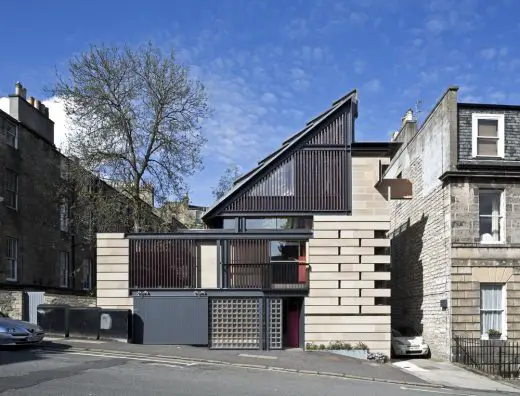
photo : Keith Hunter
Covert House, Clapham, south London, by DSDHA
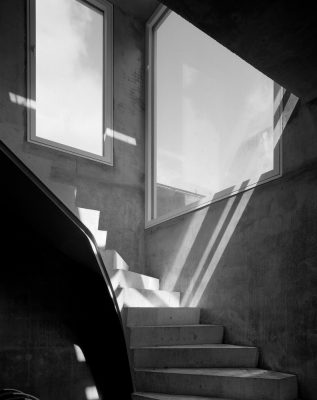
photo : Hélène Binet
RIBA Awards
RIAS Award for Architecture – Best Building in Scotland
Comments / photos for the RIBA House of the Year 2021 Longlist page welcome

